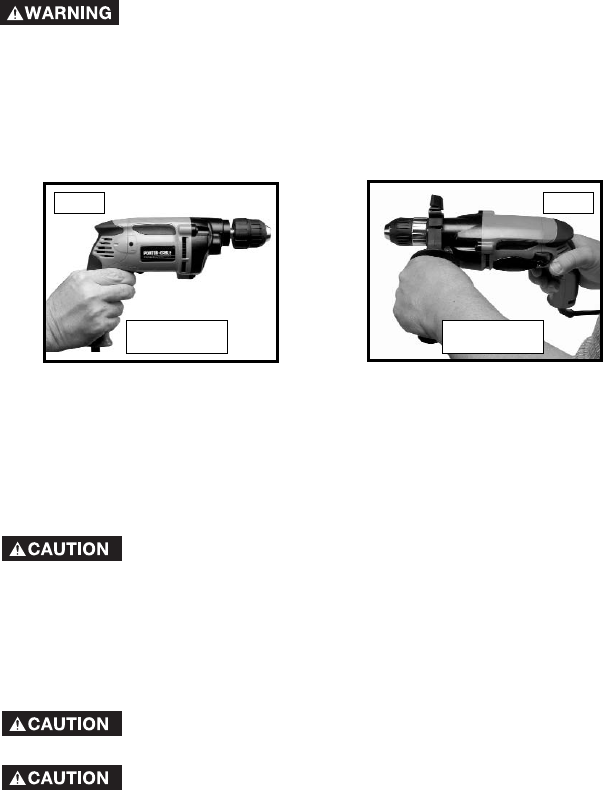
10
3. Your tool will operate in either the forward direction (clockwise rotation)
for drilling holes, or the reverse direction (counter-clockwise rotation) for
releasing jammed drill bits. For counter-clockwise rotation, stop the
motor by releasing the trigger switch. Push the reversing switch (C) Fig.
4 for counter-clockwise rotation, release the jam, then return to the
switch to clockwise rotation for drilling.
NOTE: Never attempt to change the direction of rotation while the switch is
“ON”. To do so may damage interlock feature built into switch. Be sure that
the switch is “OFF” and the motor has completely stopped before changing
the direction of rotation.
4. VARIABLE SPEED – As the trigger switch is squeezed, the drill speed
increases.
HOW TO HOLD THE DRILL
The front end of tool may become “live” if the bit drills into live
wiring in a wall. To prevent accidental electrical shock, hold the drill as
shown in Fig. 5 or 6. Apply forward force on the pistol grip handle only,
and only with your hands.
An auxiliary handle is supplied with some models. Use the auxiliary handle
on those models during all drilling operations. Grasp the auxiliary handle
with one hand to resist rotational force ONLY.
Model 2610
illustrated
HOW TO USE THE DRILL
1. Be sure that the chuck securely grips the drill bit. (See "INSTALLING
AND REMOVING DRILL BITS").
2. Set the REVERSING SWITCH for clockwise rotation.
3. Use a vise to hold the workpiece securely or clamp it in place prior to
starting the drilling operation.
A loose workpiece may spin and cause bodily injury.
4. Use a center punch to make a small dent in the workpiece at the
location where you want the hole.
5. Place the tip of the drill bit in that dent, hold the drill square with the
workpiece, and start the motor. Apply steady, even pressure to keep the
drill bit cutting. Too little pressure will keep the bit from cutting and dull
the edges due to excessive friction created by sliding over the surface.
Too much pressure may cause the bit to break or overheat
resulting in bodily injury or damaged drill bits.
BE ALERT and brace yourself against the twisting action of
the drill, should the bit jam in the work.
Model 2614
illustrated
Fig. 5
Fig. 6

















